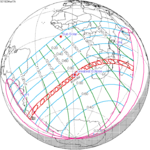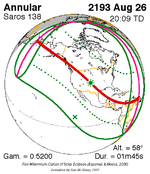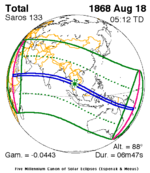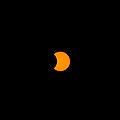Solar eclipse of May 10, 2013
| Solar eclipse of May 10, 2013 | |
|---|---|
 Annularity viewed from Churchills Head, Australia. | |
| Type of eclipse | |
| Nature | Annular |
| Gamma | −0.2694 |
| Magnitude | 0.9544 |
| Maximum eclipse | |
| Duration | 363 s (6 min 3 s) |
| Coordinates | 2°12′N 175°30′E / 2.2°N 175.5°E |
| Max. width of band | 173 km (107 mi) |
| Times (UTC) | |
| (P1) Partial begin | 21:25:10 |
| (U1) Total begin | 22:30:34 |
| Greatest eclipse | 0:26:20 |
| (U4) Total end | 2:19:58 |
| (P4) Partial end | 3:25:23 |
| References | |
| Saros | 138 (31 of 70) |
| Catalog # (SE5000) | 9537 |
An annular solar eclipse occurred at the Moon's descending node of orbit between Thursday, May 9 and Friday, May 10, 2013,[1][2][3] with a magnitude of 0.9544. A solar eclipse occurs when the Moon passes between Earth and the Sun, thereby totally or partly obscuring the image of the Sun for a viewer on Earth. An annular solar eclipse occurs when the Moon's apparent diameter is smaller than the Sun's, blocking most of the Sun's light and causing the Sun to look like an annulus (ring). An annular eclipse appears as a partial eclipse over a region of the Earth thousands of kilometres wide. Occurring about 3.6 days before apogee (on May 13, 2013, at 14:30 UTC), the Moon's apparent diameter was smaller.[4]
Annularity was visible from parts of Western Australia, Northern Territory and Queensland, Australia, the Louisiade Archipelago (belonging to Papua New Guinea), the Solomon Islands, and Kiribati. A partial eclipse was visible for parts of Indonesia, Australia, New Zealand, Oceania, and Hawaii.
Visibility
[edit]Animation of eclipse path |
Annularity was visible from a 171 to 225 kilometre-wide track that traversed Australia, eastern Papua New Guinea, the Solomon Islands, and the Gilbert Islands, with the maximum of 6 minutes 3 seconds visible from the Pacific Ocean east of French Polynesia.
Images
[edit]-
Simulation of greatest annularity east of Marakei, Kiribati.
-
Anthony Lagoon, Australia, 22:20 GMT (May 9)
-
Partial from Manly Beach, New South Wales, 22:30 GMT (May 9)
-
Partial from Docklands, Victoria, 22:49 GMT (May 9)
-
Partial from Rockhampton, Queensland, 22:57 GMT (May 9)
-
Bairiki, Kiribati, 0:15 GMT
-
Eclipse shadows from a coconut leaf shadow. From Tarawa, Kiribati at 0:30 GMT
-
Partial from Waikiki, Hawaii, 2:12 GMT
Eclipse details
[edit]Shown below are two tables displaying details about this particular solar eclipse. The first table outlines times at which the moon's penumbra or umbra attains the specific parameter, and the second table describes various other parameters pertaining to this eclipse.[5]
| Event | Time (UTC) |
|---|---|
| First Penumbral External Contact | 2013 May 09 at 21:26:16.9 UTC |
| First Umbral External Contact | 2013 May 09 at 22:31:41.4 UTC |
| First Central Line | 2013 May 09 at 22:33:47.5 UTC |
| First Umbral Internal Contact | 2013 May 09 at 22:35:53.8 UTC |
| First Penumbral Internal Contact | 2013 May 09 at 23:46:27.1 UTC |
| Equatorial Conjunction | 2013 May 10 at 00:20:48.1 UTC |
| Greatest Eclipse | 2013 May 10 at 00:26:20.3 UTC |
| Ecliptic Conjunction | 2013 May 10 at 00:29:30.5 UTC |
| Greatest Duration | 2013 May 10 at 00:36:27.6 UTC |
| Last Penumbral Internal Contact | 2013 May 10 at 01:06:21.8 UTC |
| Last Umbral Internal Contact | 2013 May 10 at 02:16:49.4 UTC |
| Last Central Line | 2013 May 10 at 02:18:57.6 UTC |
| Last Umbral External Contact | 2013 May 10 at 02:21:05.6 UTC |
| Last Penumbral External Contact | 2013 May 10 at 03:26:30.5 UTC |
| Parameter | Value |
|---|---|
| Eclipse Magnitude | 0.95443 |
| Eclipse Obscuration | 0.91093 |
| Gamma | −0.26937 |
| Sun Right Ascension | 03h08m17.4s |
| Sun Declination | +17°36'34.3" |
| Sun Semi-Diameter | 15'50.4" |
| Sun Equatorial Horizontal Parallax | 08.7" |
| Moon Right Ascension | 03h08m28.1s |
| Moon Declination | +17°22'06.3" |
| Moon Semi-Diameter | 14'53.8" |
| Moon Equatorial Horizontal Parallax | 0°54'40.4" |
| ΔT | 67.0 s |
Eclipse season
[edit]This eclipse is part of an eclipse season, a period, roughly every six months, when eclipses occur. Only two (or occasionally three) eclipse seasons occur each year, and each season lasts about 35 days and repeats just short of six months (173 days) later; thus two full eclipse seasons always occur each year. Either two or three eclipses happen each eclipse season. In the sequence below, each eclipse is separated by a fortnight. The first and last eclipse in this sequence is separated by one synodic month.
| April 25 Ascending node (full moon) |
May 10 Descending node (new moon) |
May 25 Ascending node (full moon) |
|---|---|---|
 |
 |

|
| Partial lunar eclipse Lunar Saros 112 |
Annular solar eclipse Solar Saros 138 |
Penumbral lunar eclipse Lunar Saros 150 |
Related eclipses
[edit]Eclipses in 2013
[edit]- A partial lunar eclipse on April 25.
- An annular solar eclipse on May 10.
- A penumbral lunar eclipse on May 25.
- A penumbral lunar eclipse on October 18.
- A hybrid solar eclipse on November 3.
Metonic
[edit]- Preceded by: Solar eclipse of July 22, 2009
- Followed by: Solar eclipse of February 26, 2017
Tzolkinex
[edit]- Preceded by: Solar eclipse of March 29, 2006
- Followed by: Solar eclipse of June 21, 2020
Half-Saros
[edit]- Preceded by: Lunar eclipse of May 4, 2004
- Followed by: Lunar eclipse of May 16, 2022
Tritos
[edit]- Preceded by: Solar eclipse of June 10, 2002
- Followed by: Solar eclipse of April 8, 2024
Solar Saros 138
[edit]- Preceded by: Solar eclipse of April 29, 1995
- Followed by: Solar eclipse of May 21, 2031
Inex
[edit]- Preceded by: Solar eclipse of May 30, 1984
- Followed by: Solar eclipse of April 20, 2042
Triad
[edit]- Preceded by: Solar eclipse of July 9, 1926
- Followed by: Solar eclipse of March 10, 2100
Solar eclipses of 2011–2014
[edit]This eclipse is a member of a semester series. An eclipse in a semester series of solar eclipses repeats approximately every 177 days and 4 hours (a semester) at alternating nodes of the Moon's orbit.[6]
The partial solar eclipses on January 4, 2011 and July 1, 2011 occur in the previous lunar year eclipse set.
| Solar eclipse series sets from 2011 to 2014 | ||||||
|---|---|---|---|---|---|---|
| Descending node | Ascending node | |||||
| Saros | Map | Gamma | Saros | Map | Gamma | |
118 Partial in Tromsø, Norway |
June 1, 2011 Partial |
1.21300 | 123 Hinode XRT footage |
November 25, 2011 Partial |
−1.05359 | |
128 Annularity in Red Bluff, CA, USA |
May 20, 2012 Annular |
0.48279 | 133 Totality in Mount Carbine, Queensland, Australia |
November 13, 2012 Total |
−0.37189 | |
138 Annularity in Churchills Head, Australia |
May 10, 2013 Annular |
−0.26937 | 143 Partial in Libreville, Gabon |
November 3, 2013 Hybrid |
0.32715 | |
148 Partial in Adelaide, Australia |
April 29, 2014 Annular (non-central) |
−0.99996 | 153 Partial in Minneapolis, MN, USA |
October 23, 2014 Partial |
1.09078 | |
Saros 138
[edit]This eclipse is a part of Saros series 138, repeating every 18 years, 11 days, and containing 70 events. The series started with a partial solar eclipse on June 6, 1472. It contains annular eclipses from August 31, 1598 through February 18, 2482; a hybrid eclipse on March 1, 2500; and total eclipses from March 12, 2518 through April 3, 2554. The series ends at member 70 as a partial eclipse on July 11, 2716. Its eclipses are tabulated in three columns; every third eclipse in the same column is one exeligmos apart, so they all cast shadows over approximately the same parts of the Earth.
The longest duration of annularity was produced by member 23 at 8 minutes, 2 seconds on February 11, 1869, and the longest duration of totality will be produced by member 61 at 56 seconds on April 3, 2554. All eclipses in this series occur at the Moon’s descending node of orbit.[7]
| Series members 20–41 occur between 1801 and 2200: | ||
|---|---|---|
| 20 | 21 | 22 |
 January 10, 1815 |
 January 20, 1833 |
 February 1, 1851 |
| 23 | 24 | 25 |
 February 11, 1869 |
 February 22, 1887 |
 March 6, 1905 |
| 26 | 27 | 28 |
 March 17, 1923 |
 March 27, 1941 |
 April 8, 1959 |
| 29 | 30 | 31 |
 April 18, 1977 |
 April 29, 1995 |
 May 10, 2013 |
| 32 | 33 | 34 |
 May 21, 2031 |
 May 31, 2049 |
 June 11, 2067 |
| 35 | 36 | 37 |
 June 22, 2085 |
 July 4, 2103 |
 July 14, 2121 |
| 38 | 39 | 40 |
 July 25, 2139 |
 August 5, 2157 |
 August 16, 2175 |
| 41 | ||
 August 26, 2193 | ||
Metonic series
[edit]The metonic series repeats eclipses every 19 years (6939.69 days), lasting about 5 cycles. Eclipses occur in nearly the same calendar date. In addition, the octon subseries repeats 1/5 of that or every 3.8 years (1387.94 days). All eclipses in this table occur at the Moon's descending node.
| 21 eclipse events between July 22, 1971 and July 22, 2047 | ||||
|---|---|---|---|---|
| July 22 | May 9–11 | February 26–27 | December 14–15 | October 2–3 |
| 116 | 118 | 120 | 122 | 124 |
 July 22, 1971 |
 May 11, 1975 |
 February 26, 1979 |
 December 15, 1982 |
 October 3, 1986 |
| 126 | 128 | 130 | 132 | 134 |
 July 22, 1990 |
 May 10, 1994 |
 February 26, 1998 |
 December 14, 2001 |
 October 3, 2005 |
| 136 | 138 | 140 | 142 | 144 |
 July 22, 2009 |
 May 10, 2013 |
 February 26, 2017 |
 December 14, 2020 |
 October 2, 2024 |
| 146 | 148 | 150 | 152 | 154 |
 July 22, 2028 |
 May 9, 2032 |
 February 27, 2036 |
 December 15, 2039 |
 October 3, 2043 |
| 156 | ||||
 July 22, 2047 | ||||
Tritos series
[edit]This eclipse is a part of a tritos cycle, repeating at alternating nodes every 135 synodic months (≈ 3986.63 days, or 11 years minus 1 month). Their appearance and longitude are irregular due to a lack of synchronization with the anomalistic month (period of perigee), but groupings of 3 tritos cycles (≈ 33 years minus 3 months) come close (≈ 434.044 anomalistic months), so eclipses are similar in these groupings.
| Series members between 1801 and 2200 | ||||
|---|---|---|---|---|
 December 21, 1805 (Saros 119) |
 November 19, 1816 (Saros 120) |
 October 20, 1827 (Saros 121) |
 September 18, 1838 (Saros 122) |
 August 18, 1849 (Saros 123) |
 July 18, 1860 (Saros 124) |
 June 18, 1871 (Saros 125) |
 May 17, 1882 (Saros 126) |
 April 16, 1893 (Saros 127) |
 March 17, 1904 (Saros 128) |
 February 14, 1915 (Saros 129) |
 January 14, 1926 (Saros 130) |
 December 13, 1936 (Saros 131) |
 November 12, 1947 (Saros 132) |
 October 12, 1958 (Saros 133) |
 September 11, 1969 (Saros 134) |
 August 10, 1980 (Saros 135) |
 July 11, 1991 (Saros 136) |
 June 10, 2002 (Saros 137) |
 May 10, 2013 (Saros 138) |
 April 8, 2024 (Saros 139) |
 March 9, 2035 (Saros 140) |
 February 5, 2046 (Saros 141) |
 January 5, 2057 (Saros 142) |
 December 6, 2067 (Saros 143) |
 November 4, 2078 (Saros 144) |
 October 4, 2089 (Saros 145) |
 September 4, 2100 (Saros 146) |
 August 4, 2111 (Saros 147) |
 July 4, 2122 (Saros 148) |
 June 3, 2133 (Saros 149) |
 May 3, 2144 (Saros 150) |
 April 2, 2155 (Saros 151) |
 March 2, 2166 (Saros 152) |
 January 29, 2177 (Saros 153) |
 December 29, 2187 (Saros 154) |
 November 28, 2198 (Saros 155) | |||
Inex series
[edit]This eclipse is a part of the long period inex cycle, repeating at alternating nodes, every 358 synodic months (≈ 10,571.95 days, or 29 years minus 20 days). Their appearance and longitude are irregular due to a lack of synchronization with the anomalistic month (period of perigee). However, groupings of 3 inex cycles (≈ 87 years minus 2 months) comes close (≈ 1,151.02 anomalistic months), so eclipses are similar in these groupings.
| Series members between 1801 and 2200 | ||
|---|---|---|
 September 28, 1810 (Saros 131) |
 September 7, 1839 (Saros 132) |
 August 18, 1868 (Saros 133) |
 July 29, 1897 (Saros 134) |
 July 9, 1926 (Saros 135) |
 June 20, 1955 (Saros 136) |
 May 30, 1984 (Saros 137) |
 May 10, 2013 (Saros 138) |
 April 20, 2042 (Saros 139) |
 March 31, 2071 (Saros 140) |
 March 10, 2100 (Saros 141) |
 February 18, 2129 (Saros 142) |
 January 30, 2158 (Saros 143) |
 January 9, 2187 (Saros 144) |
|
References
[edit]- ^ "May 9–10, 2013 Annular Solar Eclipse". timeanddate. Retrieved 12 August 2024.
- ^ "Aussies see 'ring of fire' eclipse". Pacific Daily News. 2013-05-11. p. A10. Retrieved 2023-10-26 – via Newspapers.com.
- ^ ""Ring of fire' eclipse crosses Australia, Pacific". The Galion Inquirer. 2013-05-11. p. 3. Retrieved 2023-10-26 – via Newspapers.com.
- ^ "Moon Distances for London, United Kingdom, England". timeanddate. Retrieved 12 August 2024.
- ^ "Annular Solar Eclipse of 2013 May 10". EclipseWise.com. Retrieved 12 August 2024.
- ^ van Gent, R.H. "Solar- and Lunar-Eclipse Predictions from Antiquity to the Present". A Catalogue of Eclipse Cycles. Utrecht University. Retrieved 6 October 2018.
- ^ "NASA - Catalog of Solar Eclipses of Saros 138". eclipse.gsfc.nasa.gov.
- Earth visibility chart and eclipse statistics Eclipse Predictions by Fred Espenak, NASA/GSFC
- Photos:
- Cape York Annular Eclipse APOD, 5/11/13
- Partial Solar Eclipse with Airplane APOD, 5/13/13












